Cite this document
(“Diagnosis: Right-Sided Pneumonia Leading to Acute Respiratory Failure Essay”, n.d.)
Retrieved from https://studentshare.org/nursing/1431437-diagnosed-with-right-sided-pneumonia-leading-to
Retrieved from https://studentshare.org/nursing/1431437-diagnosed-with-right-sided-pneumonia-leading-to
(Diagnosis: Right-Sided Pneumonia Leading to Acute Respiratory Failure Essay)
https://studentshare.org/nursing/1431437-diagnosed-with-right-sided-pneumonia-leading-to.
https://studentshare.org/nursing/1431437-diagnosed-with-right-sided-pneumonia-leading-to.
“Diagnosis: Right-Sided Pneumonia Leading to Acute Respiratory Failure Essay”, n.d. https://studentshare.org/nursing/1431437-diagnosed-with-right-sided-pneumonia-leading-to.


